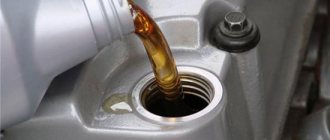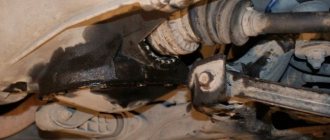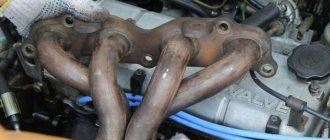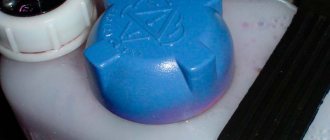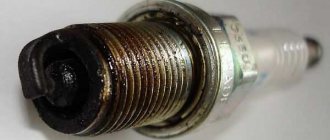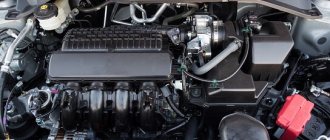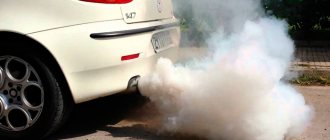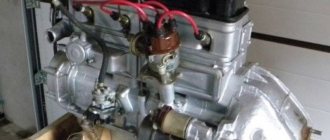While operating the vehicle, the driver may notice an oil leak between the engine and gearbox. Let us immediately note that a similar malfunction appears on different cars, regardless of what type of engine (diesel, gasoline) and gearbox are installed.
In other words, oil leaks at the junction of the transmission and internal combustion engine on different cars, when the car has a manual transmission, a robotic gearbox with one or two manual transmission clutch discs, an automatic transmission with an automatic transmission torque converter, a continuously variable transmission, etc.
In any case, if oil drips between the engine and gearbox, then this is a sign of serious damage. Faults of this kind require immediate diagnosis and quick elimination.
Next, we will talk about why an oil leak may appear between the power unit and the gearbox, as well as what the driver should do if there are visible leaks of fresh lubricant between the engine and gearbox, oil is actively running, or the lubricant on the parts is covered with dust (the leak is insignificant, there is fogging).
Oil flows between the gearbox and the engine: why does this happen?
To better understand and quickly identify the problem, let's start with the features of lubricating fluids in gearboxes and internal combustion engines. The fact is that the operating conditions of the transmission and power unit are significantly different. For this reason, motor oil is poured into the engine, and special transmission oil is poured into the gearbox. For both the engine and the gearbox, the lubricant can have a mineral, synthetic or semi-synthetic base.
However, this is where the similarities end
Please note that these liquids differ greatly in their basic properties (viscosity) and chemical additive packages. This is due to the fact that in the engine lubricant is supplied to loaded components and parts under pressure, and to elements with lower loads it is supplied by splashing
At the same time, the engine oil gets very hot, is subject to oxidative processes, etc. In most transmissions (except torque converter automatic transmissions), the mating parts are lubricated by splashing lubricant during rotation of the components; the load on the parts inside the transmission is much less compared to an internal combustion engine.
Such operating features also determine the overall service life of lubricants in each unit (on average, 10 thousand km for engine oil and 50-80 thousand for transmission oil). We also note that for each component, the vehicle manufacturer determines individual tolerances for viscosity and other lubricant parameters.
The viscosity of the engine or transmission oil is not suitable
Now let's get back to our main problem. It is quite obvious that if a leak between the gearbox and the engine appears immediately after switching from a “thicker” SAE oil to a low-viscosity lubricant (for example, mineral water was replaced with liquid synthetic), then there is a high probability of a banal discrepancy between the filled material and the recommended parameters.
If no other prerequisites for the occurrence of leaks have been identified, then it is appropriate to talk about a malfunction. In this case, analysis of the oil itself allows you to determine where it is flowing from, from the gearbox or engine. Let's take a closer look at this.
There is a malfunction in the internal combustion engine or gearbox: how to accurately determine
If the fluids poured into the engine and gearbox meet all the parameters, then an oil leak at the junction of the engine and gearbox is the result of a breakdown of one of these units. Less common, but quite possible, is the simultaneous occurrence of problems in both nodes at once.
As already mentioned, the lubricant in gearboxes and internal combustion engines differs in consistency, color and smell, which allows us to draw some conclusions
For primary diagnostics, this is very important, since it is possible to more accurately determine which unit is leaking and why. To do this, you need to carefully examine the streaks, color of the oil, dust and dirt on it.
To do this, the level is assessed using the dipstick; a decrease in the indicator will indicate problems with the motor. Let us add that the gearbox on some cars may also have its own oil dipstick. However, such a check allows you to accurately determine the problem unit when oil flows out intensively. In this case, you can usually also notice oil stains under the front of the car.
If only drips were found on surfaces and parts at the junction of the transmission and power unit, then the lubricant level does not always drop significantly. In such a situation, additional assessment of the leaking fluid helps.
Motor oil has a lighter reddish-amber hue, it is fluid, its smudges conditionally “absorb” dust and dirt. Transmission oil is usually darker and may have a reddish tint (ATF oil). This lubricant is thicker, has a characteristic pungent odor, smudges quickly become overgrown with a thick layer of dust, accumulating contaminants on its surface in the form of a “fur coat”.
Note that in practice the following method is also often used. Part of the leaking liquid must be collected in a container into which water has previously been poured. When motor oil enters water, it curls up, maintaining the shape of a drop, and then sinks down. The transmission fluid does not sink to the bottom, spreading across the surface in a spot.
On a note
Please note! The internal cavity of the gearbox of any car is necessarily connected to the atmosphere through an ordinary small-diameter tube, called a breather. Due to clogging of the ventilation channel, the air expanded as a result of heating the oil is not removed and begins to create additional pressure on the oil, leading to its leakage through the seals, and in more advanced cases, to squeezing out the sealing elements from their seats.
Cars with automatic transmissions usually have an additional external oil cooling circuit with an aluminum radiator. Due to prolonged exposure to salt, the radiator fittings begin to rot at the point of their connection with the oil supply pipes. The malfunction can be easily eliminated either by replacing the part or by welding new fittings using argon arc welding.
If oil is leaking from a brand new gearbox, the cause is likely due to a damaged crankcase or rear cover of the unit. Cracks can form as a result of non-compliance with the technology for obtaining castings of the corresponding parts of the assembly unit. If such a manufacturing defect occurs, you should immediately contact the dealership.
A crack in the “box” housing can also form due to irreversible changes in the gear shift mechanism itself. After the teeth of one of the rings are chipped, the rear cover or gearbox housing is often damaged. In this case, almost all the oil often leaks out of the internal cavity.
If
, probably the reason lies in a damaged crankcase or rear cover of the unit. Cracks can form as a result of non-compliance with the technology for obtaining castings of the corresponding parts of the assembly unit. If such a manufacturing defect occurs, you should immediately contact the dealership.
Measures to prevent oil leaks
It is impossible to completely protect your car from problems, but you can significantly reduce the likelihood of their occurrence. To do this, just follow a few simple rules:
Constantly check the lubricant level with a special dipstick. Make it a habit to monitor the amount of engine oil every 5-6 days. This measure will allow you to recognize the presence of a problem before it becomes critical. Yes, all modern cars have a special sensor that informs the driver in case of oil leakage from the engine. But it is activated only when more than 300-500 ml is consumed. Maintain your vehicle regularly. This way you can promptly notice a damaged system element and replace it with a new one. In addition, regularly changing the oil fluid will prevent the formation of soot and sludge deposits, and increase the degree of protection of motor elements from excessive wear. Buy only products recommended by your vehicle manufacturer. Your vehicle's owner's manual contains information about the recommended engine oil viscosity. Compliance with these requirements will allow you to extend the life of the propulsion system
When choosing an oil liquid, pay attention to the design of the product and the quality of its container so as not to run into a fake. As for choosing a brand, you should rely on intuition
Many companies have a good reputation in the world market, but it is impossible to say unequivocally which oil is better - after all, each vehicle has its own requirements for fuels and lubricants. Do not load the engine if it has not been properly warmed up. Did you start the car in the cold and immediately decide to drive it? Then stock up on plenty of motor oil for regular top-ups. Thickened liquid circulates unevenly in a cold system, so pressing the gas pedal can cause it to be squeezed out of the system; To prevent oil from squeezing out, it is recommended to warm up the engine for 10-15 minutes. Buy only original spare parts. If you find the reason why oil is leaking from the engine or gearbox, immediately begin repairing the car. But when choosing new parts for the system, try to give preference to original spare parts. Their quality (as well as price) is much higher than that of their “Chinese” counterparts, which means they can last your engine longer. By the way, non-original spare parts may differ in size from the original ones, which in turn will affect the tightness of the structure. If it is not possible to carry out maintenance of the vehicle yourself, entrust the work to professionals. And not to “garage technicians,” but to service centers specializing in vehicle maintenance.
Transmission fluid foams in the gearbox
During normal operation of the engine and gearbox, there are cases when the lubricant foams. Such a defect does not create direct and tangible problems. But foaming transmission fluid creates feelings of discomfort and anxiety in car owners.
Transmission oil foams for 2 main reasons:
- incorrect transmission fluid level;
- technological inconsistencies in the production characteristics of the oil.
A low or high level of lubricant in the gearbox is the most common reason that the substance foams. If the marks on the dipstick reveal an overflow of liquid, then you must immediately remove the excess amount. German cars of the brands Audi, BMW, Mercedes, Volkswagen are the most vulnerable to problems with excess oil in automatic transmissions.
It is strictly forbidden to add new oil to the automatic transmission, which is not the same as the old one according to the manufacturer. When lubricants from different manufacturers are mixed, the formation of foaming oil is guaranteed. When switching to using a fluid from another company, you need to thoroughly rinse the automatic transmission to remove any remnants of the old substance. And then completely change the oil in the automatic transmission.
Causes of malfunction
A torque converter is not a very complicated device, but during the operation of an automatic transmission it wears out and gradually fails. We list which systems can break down and for what reasons.
Friction pairs
Inside the torque converter there is a so-called locking device, which is essentially an element of the automatic clutch. Mechanically, it works similar to a classic manual transmission clutch. Accordingly, wear of the friction discs, their individual pairs, or the entire set occurs. In addition, wear elements of the friction discs (metal dust) contaminate the transmission fluid, which can cause the channels through which the fluid passes to become clogged. Because of this, the pressure in the system drops, and other elements of the automatic transmission also suffer - the valve body, cooling radiator and others.
Blade blades
Metal blades, when exposed to high temperatures and the presence of abrasives in the transmission fluid, also wear out over time and add even more metal dust to the oil. Because of this, the efficiency of the torque converter decreases, the overall fluid pressure in the transmission system decreases, and because of the dirty fluid, the overheating of the system increases, the valve body wears out, and the load on the entire system increases. In the worst cases, one or more blades on the impeller may completely break.
Destruction of oil seals
Under the influence of hot and contaminated ATP fluid, the load on rubber (plastic) seals increases. Because of this, the tightness of the system suffers, and transmission fluid may leak.
Locking automatic transmission torque converters
On older automatic transmissions the locking (clutch), which had a mechanical control, the locking itself worked less often, only in higher gears. Therefore, the service life of such boxes was longer, and the transmission fluid replacement interval was longer.
On modern cars, the locking is activated, that is, the torque converter is blocked in all gears, and a special valve regulates its pressing force. So, during smooth acceleration, the locking is partially activated, and during sharp acceleration, it turns on almost immediately. This is done to reduce fuel consumption, as well as to increase the dynamic characteristics of the machine.
One other side of the coin in this case is that in this mode of operation the wear of the locking tabs increases significantly. Including the transmission fluid quickly wears out (contaminated), and a lot of debris appears in it. As the mileage increases, the smoothness of the locking decreases, and when accelerating or during normal driving, the car will begin to twitch a little. Accordingly, the automatic transmission oil needs to be changed at approximately 60 thousand kilometers, since the entire automatic transmission system falls into the risk zone.
Bearing wear
In particular, support and intermediate ones, between the turbine and the pump. In this case, a crunching or whistling sound is usually heard, emitted directly by the bearings mentioned. Particularly crunchy sounds are heard when accelerating, but when the machine reaches a stable speed and load, the sounds usually disappear unless the bearings are worn out to a critical state.
Loss of transmission fluid properties
If ATF fluid has been in the transmission system for a long time, then it turns black, thickens, and a lot of debris appears in its composition, in particular, metal chips. Because of this, the torque converter also suffers. The situation is especially critical when the liquid not only loses its properties, but also its overall level (quantity in the system) drops. In this mode, the torque converter will operate in critical mode, at critical temperatures, which significantly reduces its overall resource.
Broken connection with the automatic transmission shaft
This is a critical failure, which, however, happens extremely rarely. It consists in the fact that a mechanical break occurs in the splined connection of the turbine wheel with the shaft of the automatic transmission. In this case, the movement of the car is basically impossible, since no torque is transmitted from the engine to the automatic transmission. Repair work consists of replacing the shaft, restoring the spline connection, or completely replacing the torque converter in critical cases.
Overrunning clutch failure
An external sign of a breakdown of the automatic transmission overrunning clutch will be a deterioration in the dynamic characteristics of the car, that is, it will accelerate worse. However, without additional diagnostics it is impossible to determine for sure that the overrunning clutch is to blame.
Let's sum it up
As you can see, drops of transmission oil under the car or obvious oiling of any areas with transmission fluid is a reason for a detailed inspection of the car. If there is no obvious suspicion that the gearbox housing has recently been damaged, then diagnostics are necessary.
Read more: Malfunction of power steering in Opel Astra: causes and methods of elimination
First of all, you need to check the oil level in the gearbox to ensure it is not overfilled. At the same time, the performance and condition of the gearbox breather should be assessed in order to prevent transmission oil from being squeezed out due to an increase in pressure in the internal cavities of the box.
Finally, we note that when purchasing a new car or after repairing a gearbox with the replacement of individual elements, one should not exclude the possibility that a defective gearbox housing (with cracks) may be installed. Also, the oil seals, cuffs and seals themselves have defects and are often of poor quality.
Gears are difficult to engage or speeds on a manual transmission do not engage: the main causes of the malfunction and possible problems.
How to choose oil for a manual transmission. Changing the oil in a manual transmission, frequency and features of changing transmission oils in a manual transmission.
Simple factors
Circumstances of negligence and incompetence - both of auto mechanics and the owner of the car - can be easily eliminated. Among them:
- loose nut on the drain. He made it through - and off he went;
- The reverse sensor is loosely screwed in. The recommendations are the same;
- The dipstick for measuring the oil level is not inserted tightly (or crookedly, which is worse). Hammered it in tighter, adjusted it - job done;
- oil overflow. Generosity is not always good, and a new driver must learn this. It says “maximum”, which means stop. Excess oil will still have to be drained, and this, again, is a loss of money.
However, if you come across such a simple option, you can start to rejoice. Other reasons cannot be dealt with so easily. Leaking through the lid:
Most often this happens due to gasket wear. And this case, again, is simple and can be corrected without difficulty. You buy a new one, replace it - you don’t even need to go to a service station. It’s a little worse if chips or deep but small scratches are found. In this case, epoxy is used, with the help of which the (relatively) evenness of the surface is restored.
{banner_content}
Consequences of untimely repairs
Why oil leaves the engine and where it is determined. Now it’s worth considering the consequences of untimely repairs. As you know, an engine without oil cannot move, since oil not only has lubricating properties, but also has cooling properties. Therefore, the consequences of a low oil level in the engine will be fatal, especially during long-term operation of the power unit. Let's consider the main consequences:
- Increased wear on the crankshaft and piston group. Thus, an insufficient oil level can lead to significantly higher production.
- Increased wear of parts will lead to the appearance of a large amount of metal shavings in the remaining lubricant, which will further increase the degree of wear of parts. Thus, the oil seals and sealing elements are the first to wear out.
- Also, a low oil level, both in the box and in the engine, leads to the engine overheating greatly, and accordingly there is a possibility that the engine will overheat and the cylinder head will become deformed or deflected.
Looking for reasons
Oil leakage from a car engine or gearbox may begin immediately after it is replaced. The presence of smudges may indicate that the fresh fluid does not meet the requirements stated by the car manufacturer. For example, instead of the usual thick mineral water, you decided to use liquid synthetics. If the car refuses to accept it, you will know about it immediately. This problem can be easily resolved - just fill the engine or transmission with oil with the required viscosity.
If the lubricants used have the required parameters, and smudges are still visible on the engine or gearbox, then the situation may be serious. Failure of one, even the smallest component, can disrupt the tightness of systems and cause oil starvation
This is why it is so important to fix the leak in a timely manner.
Primary diagnosis begins with studying the consistency, smell and color of the leaked liquid. Gearbox fuels and lubricants have a dark, sometimes reddish tint and a very pungent odor. The liquid is thick and does not absorb contaminants. Those. a drop of transmission oil will be covered with a layer of dust, but will not absorb it.
As for motor lubricant, it will behave differently towards contaminants: it completely absorbs them. Fuel and lubricants for internal combustion engines have a more liquid base, a reddish-amber tint and a faint odor.
If visual inspection of smudges is difficult due to the design features of the car, then the problem can be solved using an oil dipstick. Measure the fluid level in the engine compartment; deviation of this indicator from the norm will indicate a problem.
Some modern cars have a dipstick to check the oil level in the box. But it will only identify the problem if the lubricant is rapidly leaking out of the gearbox. In these cases, dark stains of technical fluid can be recognized under the front of the car. Minor leaks at the lubricant level will not be immediately noticeable; the dipstick will not be able to “notice” them.
Grease leaks from the engine
If an inspection of the car and a study of the condition of the leaking fluid gave reason to believe that the problem lies in the engine compartment, then it is necessary to identify the weakest points of the system through which the oil could escape.
Reasons for failure:
- Overflow of liquid. No matter how trivial it may sound, oil can leak due to its overflow into the oil compartment. If you filled in lubricant “by eye” and did not check its level, a leak may form around the entire perimeter of the engine. The excess amount of material circulating under high pressure in the internal combustion engine will simply be squeezed out of the working space and flow down the outer sides of the internal combustion engine. The problem can be easily fixed: unscrew the oil plug at the bottom of the engine and allow excess fluid to drain out of the crankcase.
- Wear, incorrect installation or destruction of sealing elements. If the car has been sitting for a long time, the seals and gaskets may have failed due to insufficient moisture. After starting the car, they cannot function normally (their ability to be elastic is lost), and therefore lubricant leaks out. The solution in this case is to replace the problematic parts with new ones; You can read on the Internet how to correctly install sealing parts to eliminate oil leaks in the engine.
- Insufficient crankcase ventilation. Excessive accumulation of exhaust gases in the car crankcase can create additional pressure and squeeze consumables out. This situation occurs when the ventilation system ducts are clogged. An oil deflector valve will help diagnose this problem. Check its condition. Did you see a bluish or dark brown coating? This means that the reason for the leaks lies precisely here. If the presence of deposits still raises doubts about insufficient crankcase ventilation, cover the open oil filler neck with a small sheet of white cardboard and start the car engine (it is recommended to keep it at 900-1100 rpm). A tight fit of the cardboard to the oil fill hole indicates normal operation of the ventilation system. Otherwise, it is necessary to clean or replace the engine pipes.
- Valve cover deformation. In rare cases, when car manufacturers use low-quality metal, a violation of the valve cover geometry may occur, which will be accompanied by large oil losses. Unfortunately, installing a new gasket will not solve the problem. The only possible option is to replace this very cover.
Engine malfunction
Often the cause of oil leakage is a leak in the rear oil seal on the engine crankshaft. Such risks especially increase in cars with high mileage. The oil seal may be squeezed out due to worn crankshaft thrust rings. Rough oil-resistant rubber edges will not stop the hot oil. It will definitely break out.
The appearance of a leak is the result of the accumulation of an increased amount of gases in the engine crankcase. This situation is very likely due to wear of the cylinder-piston group and contamination of the gas exhaust system. The ventilation ducts of worn engines and gearboxes are extremely dirty. The pressure in the crankcase increases, and the cuffs, gaskets or seals cannot withstand the lubricant rushing out.
Crankcase ventilation is checked through the condition of the oil deflector valve. It is installed in the valve cover. A bluish or dark brown coating on the valve indicates problems with crankcase ventilation. To final check the functionality of the system, perform the following operation:
- remove the oil filler cap;
- cover the neck with thick cardboard;
- start the engine;
- bring the crankshaft speed to 1000 rpm.
The operation of the ventilation system is considered normal if the cardboard is tightly pulled to the neck due to the vacuum formed in the crankcase. Otherwise, the connecting rubber tubes are cleaned of internal carbon deposits. If this does not help, then the tubes must be replaced.
Oil leaks through the rear oil seal located on the engine crankshaft not only contribute to a noticeable decrease in the fluid level in the sump. Loss of lubricant through this channel often leads to it ending up on the clutch parts. This causes it to slip and prevents further normal movement of the car.
The corresponding indicator located on the instrument panel will indicate insufficient oil pressure in the engine. In case of such an alarm signal, the operation of the vehicle must be suspended.
The operation of the ventilation system is considered normal if the cardboard is tightly pulled to the neck due to the vacuum formed in the crankcase. Otherwise, the connecting rubber tubes are cleaned of internal carbon deposits. If this does not help, then the tubes must be replaced.
Oil leaks through the rear oil seal located on the engine crankshaft not only contribute to a noticeable decrease in the fluid level in the sump. Loss of lubricant through this channel often leads to it ending up on the clutch parts. This causes it to slip and prevents further normal movement of the car.
Signs and causes of leaks
To deal with the problem, you need to know about its causes and symptoms. What are the signs to determine that oil is leaking from the engine? Engine fluid leakage is sometimes caused by clutch slippage. If engine fluid gets onto the intake manifold or exhaust pipe, you will notice unpleasant odors or see blue smoke coming from under the hood.
Oil stains due to fluid leakage from the engine
After the night, pay attention to the place where your vehicle was parked. Oil stains under the engine may indicate that oil has leaked from it and the problem needs to be addressed
The main sign is the nature of the oil stain. It will be either yellow or dark, and in appearance it will be a slippery and greasy stain.
In addition, another sign that fluid is leaking from the engine is its insufficient level. If the oil is completely squeezed out while driving or it leaves the engine while parked, then, of course, the level will be at its lowest. Therefore, drivers are recommended to check the engine fluid level before each vehicle operation. In addition, the instrument panel may indicate this problem. If the oil level is insufficient and it has partially leaked out, you will see a characteristic icon of a lack of fluid in the engine on the dashboard.
As for the reasons, they are discussed below:
The intake manifold control system has failed. The engine fluid level sensor is not sealing - if a leak is observed in the area of the sensor. The filter element is not tight - if liquid flows into the oil filter area. Leaking motor seals. The wrong MM is loaded into the system. Sometimes car owners do not take into account the recommendations of the car manufacturer regarding the choice of consumables. Of course, this should not be ignored
The fluid should be filled only with that specified by the manufacturer, as this is very important. the performance of consumables is affected by the additive package, chemical composition, and viscosity properties
Elements contained in the wrong oil can corrode the rubber components of the injection system, which can cause the oil to completely leak out of the car. Overflow of liquid. If you have poured too much consumable material into the engine, this may cause an increase in the operating pressure of the MM. As a result of increased pressure, the level of load on the sealing elements along with the seals will increase. Accordingly, this may cause destruction of the structure. Transport has not been used for a long time. If your car’s engine does not heat up for twenty days, the liquid may drain into the oil pan, and all the sealing elements along with the seals will begin to dry out due to downtime. Insufficient crankcase ventilation. Every motorist knows that exhaust gases enter the crankcase through the pistons. The piston bores will allow more gases to pass through if the engine is quite old. When these gases collect in the crankcase, excessive pressure is created in the system. The ventilation system should reduce this pressure, but if its channels are clogged, then there can be no talk of any reduction in pressure. Accordingly, the pressure will squeeze out the consumables. The cylinder head gasket is broken. This sealing element can be damaged anywhere, causing liquid to leak out. However, if the gasket is broken, this does not mean that the liquid will come out. It can also leak into the cooling system if the part located between the cylinders and the cooling system is broken. In this case, everything can be understood by the color of the antifreeze - it will be more cloudy. In addition, the car will lose power, the coolant will constantly foam, and the engine will regularly overheat.
We recommend: Wires for lighting a car: choosing the best
What should you keep in mind?
Undesirable consequences can be caused by mixing fluids of different manufacturers and viscosity characteristics: if the oil leaks while driving, and there is nothing to top it up with, the car cannot be operated further. Call a tow truck and take the car to the nearest service station. Adding oil of a different composition - transmission or engine - is not allowed due to the fact that a destructive chemical reaction may begin inside the installation, which in turn will lead to even greater consequences. Of course, if a loss of fluid occurs on the highway, the driver can fill the system with oil at hand, but only to get to the specialists. In the future, the oil “compote” will have to be drained, and the installation into which it was poured will have to be thoroughly rinsed.
Connecting the gearbox to the engine: features and nuances
Let us immediately note that the connection of a manual transmission, as well as a robotic transmission, is somewhat different from a similar operation with another type of transmission, that is, an automatic torque converter automatic transmission. Otherwise, the usual mechanics and the “robot” (especially the single-disc one) are very similar in design.
This means that such boxes are connected to the motor in almost the same way. However, if we talk about an automatic transmission, the installation of this unit involves a number of individual differences.
So, let's start with the manual transmission using the example of the popular Hyundai Getz model. This type of box can be connected in any garage, even without an inspection hole
It is important to take into account that a certain free space under the car is still necessary
To solve the problem, you need to raise the front axle of the car by placing wooden blocks, etc. It is also advisable to invite an assistant before starting work, but in extreme cases you can do it yourself.
Having raised the car, it is necessary to first remove the intermediate steering rod, since the element will complicate the process of connecting the engine and gearbox, taking into account the installation at an angle relative to the body.
The gearshift lever must also be removed from the gearbox, and the hole after removal should be closed using a rag, masking tape, etc.
Please note that after installing the box, the specified lever will be mounted from the passenger compartment, so you should figure out in advance, with the transmission removed, how this element is installed back into the box
Even before removing the lever, you need to engage fourth gear. Let us add that in the case when the clutch assembly was removed from the engine, it is imperative to center the driven disk in relation to the support bearing. This is done using a special mandrel or by removing the input shaft from the box.
If this is not done, the input shaft will not fit into the specified place during installation, that is, it will not be possible to install the gearbox. Next, loosen the bolts on the engine mounts, loosening the nuts that secure the upper metal brackets. This is necessary so that the engine has the opportunity to position itself at a certain angle, without the risk of damaging the cushions themselves.
The front of the engine is then raised slightly just before the box is installed. As a result, the rear part (the area where the clutch is installed) is lowered slightly, and the gearbox, when installed from below, has the opportunity to enter the tunnel and connect to the internal combustion engine.
In this case, it is important to prepare in advance all the necessary tools, fasteners, etc., and also arrange them so as to gain easy access. We are talking about the head, spanners, bolts securing the box to the engine and other elements
Now you can proceed to the installation stage. If you have not previously practiced this operation and do not know how to connect the engine to the gearbox, carefully study the following recommendations:
- You need to be prepared for the fact that you will have to lie on your back and hold the gearbox while lifting the unit with your hands. The task comes down to getting the input shaft into the clutch driven disc.
- Next, the gearbox housing will need to be “scrolled” a little so that, together with the output flange (or rubber coupling), it will be possible to align the splines on the input shaft with the splines of the driven disk.
- Once the splines are aligned, the box will slide toward the engine with relative ease under little force. The only caveat is that certain difficulties may arise with the guide bushings.
- After installation, you need to tighten one or a pair of bolts to prevent the box from detaching. Next, you should tighten all the remaining fasteners with the required force and in the required order (information can be found in the manual).
How to change the rear oil seal?
This procedure is quite complicated, since the element is located behind the clutch system. If it is a rear-wheel drive car, the driveshaft is removed. Next, as on front-wheel drive vehicles, there is a gearbox, a clutch assembly with a basket and discs, as well as an engine flywheel. The rear oil seal itself is installed in the housing and secured with eight bolts.
After unscrewing them, take out the housing and press in a new element. If you have difficulty installing it, you can use a rubber hammer or a regular steel hammer using a soft spacer. The latter can be made from a piece of an old car camera. Next, all the elements are assembled in reverse order.
Signs and causes of engine oil leaks
First of all, it is important to remember that before each trip, the driver needs to conduct a visual inspection of the engine compartment. It wouldn’t hurt to look under the engine crankcase and also pull out the oil dipstick
This approach will help to identify and eliminate the problem in a timely manner without serious consequences. In most cases, engine oil leaks are observed at the junctions of engine components and components. These include:
- valve lid;
- cylinder head;
- engine sump;
- crankshaft oil seal flange;
- oil filter.
What can cause an oil leak from the engine?
It is impossible to answer this question unambiguously, since in each specific case this problem may be caused by a specific malfunction of one or another mechanism.
Nevertheless, there is a list of the most common breakdowns that lead to depressurization of the engine lubrication system. Namely:
- wear and loss of elasticity of sealing elements;
- increased wear of engine working elements;
- mechanical damage to motor elements.
The first and, perhaps, the most common cause of oil leaks from internal combustion engines is wear of the seals. After prolonged use, oil seals and gaskets lose their properties and begin to leak oil. The problem is solved by replacing them.
It is also worth noting that failure of the sealing elements could occur due to a discrepancy between their performance characteristics and the stated requirements. In this case, we are talking about various fakes and handicraft analogues of factory rubber goods.
The vehicle's mileage may also create favorable conditions for the problem presented to occur. For example, increased wear of piston rings leads to increased pressure in the engine crankcase due to the appearance of so-called crankcase gases. This unfavorable situation can cause the engine pan gasket and valve covers to leak.
Mechanical damage to the motor should not be discounted.
Front
It is much easier to change than the rear one. The element is located at the end of the crankshaft (on cars with a transverse engine - near the right pillar). To replace, we need to remove the timing belt cover and place the piston of the first cylinder at TDC. We loosen the tensioners and remove the timing belt from the outside, as well as the generator, having first removed the pulley.
Drain the engine oil. Remove the crankshaft pulley. Unscrew the oil pump. An oil seal will be pressed inside it. You can remove it using a minus screwdriver. The new one is pressed in using a large head (27 and above) or on a special machine. Further assembly is in reverse order.
Oil flows between the gearbox and the engine: why does this happen?
To better understand and quickly identify the problem, let's start with the features of lubricating fluids in gearboxes and internal combustion engines. The fact is that the operating conditions of the transmission and power unit are significantly different. For this reason, motor oil is poured into the engine, and special transmission oil is poured into the gearbox. For both the engine and the gearbox, the lubricant can have a mineral, synthetic or semi-synthetic base.
However, this is where the similarities end
Please note that these liquids differ greatly in their basic properties (viscosity) and chemical additive packages. This is due to the fact that in the engine lubricant is supplied to loaded components and parts under pressure, and to elements with lower loads it is supplied by splashing
At the same time, the engine oil gets very hot, is subject to oxidative processes, etc. In most transmissions (except torque converter automatic transmissions), the mating parts are lubricated by splashing lubricant during rotation of the components; the load on the parts inside the transmission is much less compared to an internal combustion engine.
Such operating features also determine the overall service life of lubricants in each unit (on average, 10 thousand km for engine oil and 50-80 thousand for transmission oil). We also note that for each component, the vehicle manufacturer determines individual tolerances for viscosity and other lubricant parameters.
The viscosity of the engine or transmission oil is not suitable
Now let's get back to our main problem. It is quite obvious that if a leak between the gearbox and the engine appears immediately after switching from a “thicker” SAE oil to a low-viscosity lubricant (for example, mineral water was replaced with liquid synthetic), then there is a high probability of a banal discrepancy between the filled material and the recommended parameters.
To put it simply, the use of low-viscosity lubricants in gearboxes and internal combustion engines can lead to leaks. So what does this information give us? Most importantly, if the oil in the engine or gearbox turns out to be unsuitable, then leakage can be easily eliminated by replacing the lubricant with the recommended one.
If no other prerequisites for the occurrence of leaks have been identified, then it is appropriate to talk about a malfunction. In this case, analysis of the oil itself allows you to determine where it is flowing from, from the gearbox or engine. Let's take a closer look at this.
Oil leaks caused by problems with the gearbox
Lubricant leakage occurs not only from under engine parts, but also from the gearbox. In cars equipped with manual transmissions, transmission fluid rarely leaks out. In such gearboxes, the lubricant level is lower than the input shaft bearing.
It is much more common for transmission fluid to leak from automatic transmissions. In such units, the lubricant is supplied to the rubbing parts by force. An oil pump is used for this. As a result, the internal pressure in the lubrication system of the automatic transmission increases.
The main culprit in the problem of oil leakage from the automatic transmission is the torque converter. In many situations, it goes out of service at the same time as the pump. Forced replacement of the listed parts entails significant financial costs. Moreover, repairs sometimes turn out to be ineffective. Then it is easier to purchase a new automatic transmission than to repair the old one.
